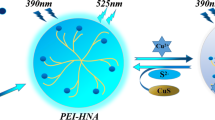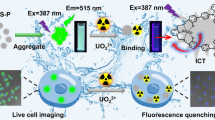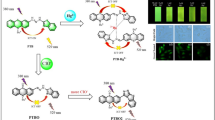Abstract
The detection of heavy metals such as Hg2+ and Ag+ is important and urgent. In this work, – NO2/– NH2/C=S boron dipyrromethene small molecular derivatives were synthesized at first. Then they were incorporated into polymer chains. The macromolecular fluorescent probes were obtained via Sonogashira reaction using the small molecular probes as building blocks. The as-prepared small-molecule fluorescent probe BO3 exhibits high sensing performance for Hg2+. By introducing it into macromolecules, the sensing ability still remains, and even more, the recognition performance is improved. The macromolecular fluorescent probes P1, P2, and P3 also have high recognition ability for Ag+ with a binding ratio of 2:1 (metal ion to probe ratio). Through the study of the sensing mechanism and the recycling experiments, it is found that the probes responded by the photo-induced electron transfer mechanism and can be recycled and reused. At the same time, BO3, P2, and P3 show excellent recognition performance for Hg2+ in living cells and zebrafish. Living cell imaging experiments indicated that these fluorescent probes had good cell membrane permeability and low cytotoxicity, and could realize bioimaging of Hg2+. Therefore, the application value of these fluorescent probes could be enlarged.

Graphical abstract










Similar content being viewed by others
References
Fernando JFS, Shortell MP, Firestein KL, Zhang C, Larionov KV, Popov ZI, et al. Photocatalysis with Pt-Au-ZnO and Au-ZnO hybrids: effect of charge accumulation and discharge properties of metal nanoparticles. Langmuir. 2018;34(25):7334–45.
Hu H, Wang Z, Pan L. Synthesis of monodisperse Fe3O4@silica core-shell microspheres and their application for removal of heavy metal ions from water. J Alloy Compd. 2010;492(1–2):656–61.
Somura H, Takeda I, Mori Y. Influence of puddling procedures on the quality of rice paddy drainage water. Agr Water Manage. 2009;96(6):1052–8.
Zhu D, Zhao D, Huang J, Li J, Zuo X, Wang L, et al. Protein-mimicking nanoparticle (Protmin)-based nanosensor for intracellular analysis of metal ions. Nucl Sci Tech. 2018;29(1).
Huppertsberg S, Knepper TP. Instrumental analysis of microplastics–benefits and challenges. Anal Bioanal Chem. 2018;410(25):6343–52.
Winsberg J, Hagemann T, Muench S, Friebe C, Häupler B, Janoschka T, et al. Poly (boron-dipyrromethene)–a redox-active polymer class for polymer redox-flow batteries. Chem Mater. 2016;28(10):3401–5.
Li J, Liu Q, Wan Y, Wu X, Yang Y, Zhao R, et al. Rapid detection of trace Salmonella in milk and chicken by immunomagnetic separation in combination with a chemiluminescence microparticle immunoassay. Anal Bioanal Chem. 2019;411(23):6067–80.
Golcs Á, Horváth V, Huszthy P, Tóth T. Fast potentiometric analysis of lead in aqueous medium under competitive conditions using an acridono-crown ether neutral ionophore. Sensors-Basel. 2018;18(5):1407.
Jia J, Gu Z, Li R, Huang M, Xu C, Wang Y, et al. Design and synthesis of fluorescent sensors for zinc ion derived from 2-aminobenzamide. Eur J Org Chem. 2011;2011(24):4609–15.
Strehl C, Gaber T, Jakstadt M, Hahne M, Hoff P, Spies CM, et al. High-sensitivity immunofluorescence staining: a comparison of the liposome procedure and the FASER technique on mGR detection. J Fluoresc. 2013;23(3):509–18.
Zhou Q, Lin Y, Xu M, Gao Z, Yang H, Tang D. Facile synthesis of enhanced fluorescent gold–silver bimetallic nanocluster and its application for highly sensitive detection of inorganic pyrophosphatase activity. Anal Chem. 2016;88(17):8886–92.
Niu B, Xiao K, Huang X, Zhang Z, Kong X, Wang Z, et al. High-sensitivity detection of iron (III) by dopamine-modified funnel-shaped nanochannels. Acs Appl Mater Inter. 2018;10(26):22632–9.
Korganbayev S, Min R, Jelbuldina M, Hu X, Caucheteur C, Bang O, et al. Thermal profile detection through high-sensitivity fiber optic chirped Bragg grating on microstructured PMMA fiber. J Lightwave Technol. 2018;36(20):4723–9.
Davis EJ, Jones M, Thiel DA, Pauls S. Using open-source, 3D printable optical hardware to enhance student learning in the instrumental analysis laboratory. J Chem Educ. 2018;95(4):672–7.
Cha Y, Price T, Wei Z, Lu X, Rewkowski N, Chabra R, et al. Towards fully mobile 3D face, body, and environment capture using only head-worn cameras. Ieee T Vis Comput Gr. 2018;24(11):2993–3004.
Zhang X, Zhang GQ, Zhu J. Methylated unsymmetric BODIPY compounds: synthesis, high fluorescence quantum yield and long fluorescence time. J Fluoresc. 2019;29(2):407–16.
Müller K, Klapper M, Müllen K. Synthesis of conjugated polymer nanoparticles in non-aqueous emulsions. Macromol Rapid Comm. 2006;27(8):586–93.
Xu Q, An L, Yu M, Wang S. Design and synthesis of a new conjugated polyelectrolyte as a reversible pH sensor. Macromol Rapid Comm. 2008;29(5):390–5.
Gao F, Liao Q, Xu Z, Yue Y, Wang Q, Zhang H, et al. Strong two-photon excited fluorescence and stimulated emission from an organic single crystal of an oligo (phenylene vinylene). Angew Chem. 2010;49(4):732–5.
He T, Tang D, Lin C, Shen X, Lu C, Xu L, et al. Conjugated polymers containing BODIPY and fluorene units for sensitive detection of CN− ions: site-selective synthesis, photo-physical and electrochemical properties. Polymers-Basel. 2017;9(12):512.
Shi W, Lo P, Singh A, Ledoux-Rak I, Ng DKP. Synthesis and second-order nonlinear optical properties of push-pull BODIPY derivatives. Tetrahedron. 2012;68(42):8712–8.
Babkina SS, Ulakhovich NA. Complexing of heavy metals with DNA and new bioaffinity method of their determination based on amperometric DNA-based biosensor. Anal Chem. 2005;77(17):5678–85.
Chu H, Lee K, Lim S, Kim T. Enhancing the performance of a silicon anode by using a new conjugated polymer binder prepared by direct arylation. Macromol Res. 2018;26(8):738–43.
Duan Y, Zhang J, Fan X, Xu K. Influence of one CO molecule on structural and electronic properties of monatomic Cu chain. Phys. E: 2015;73:89–95.
Hofmann D, Tenzer S, Bannwarth MB, Messerschmidt C, Glaser S, Schild H, et al. Mass spectrometry and imaging analysis of nanoparticle-containing vesicles provide a mechanistic insight into cellular trafficking. ACS Nano. 2014;8(10):10077–88.
Joo Y, Huang L, Eedugurala N, London AE, Kumar A, Wong BM, et al. Thermoelectric performance of an open-shell donor-acceptor conjugated polymer doped with a radical-containing small molecule. Macromolecules. 2018;51(10):3886–94.
Figliola C, Robertson KN, Greening S, Thompson A. Asymmetric dipyrrin and F -BODIPYs conjugated to terminal alkynes and alkenes. J Org Chem. 2017;82(13):7059–64.
Bruschi M, Limacher PA, Hutter J, Lüthi HP. A scheme for the evaluation of electron delocalization and conjugation efficiency in linearly π-conjugated systems. J Chem Theory Comput. 2009;5(3):506–14.
Madhu S, Sharma DK, Basu SK, Jadhav S, Chowdhury A, Ravikanth M. Sensing Hg (II) in vitro and in vivo using a benzimidazole substituted BODIPY. Inorg Chem. 2013;52(19):11136–45.
Zhang X, Xiao Y, Qian X. A ratiometric fluorescent probe based on FRET for imaging Hg2+ ions in living cells. Angew Chem. 2008;120(42):8145–9.
Devaraj NK, Weissleder R. Biomedical applications of tetrazine cycloadditions. Accounts Chem Res. 2011;44(9):816–27.
Huang X, Meng J, Dong Y, Cheng Y, Zhu C. Polymer-based fluorescence sensors incorporating chiral binaphthyl and benzo[2,1,3] thiadiazole moieties for Hg2+ detection. J Polym Sci. Part A: Polymer Chemistry. 2010;48(5):997–1006.
Culzoni MJ, Muñoz DL, Machuca A, Goicoechea HC, Brasca R, Babiano R. Photoinduced electron transfer fluorometric Hg (II) chemosensor based on a BODIPY armed with a tetrapod receptor. Talanta. 2013;117:288–96.
Wei G, Jiang Y, Wang F. A novel AIEE polymer sensor for detection of Hg2+ and Ag+ in aqueous solution. J Photochem. 2018;358:38–43.
Ngoy BP, Molupe N, Harris J, Fomo G, Mack J, Nyokong T. Photophysical studies of 2,6-dibrominated BODIPY dyes substituted with 4-benzyloxystyryl substituents. J Porphyr Phthalocya. 2017;21(04–06):431–8.
Kim H, Kim K, Son S, Choi JY, Lee K, Kim B, et al. 18 F-labeled BODIPY dye: a potential prosthetic group for brain hybrid PET/optical imaging agents. ACS Chem Neurosci. 2019;10(3):1445–51.
Joshi M, Delgado Y, Guerra P, Lai H, Almirall JR. Detection of odor signatures of smokeless powders using solid phase microextraction coupled to an ion mobility spectrometer. Forensic Sci Int. 2009;188(1–3):112–8.
Harner T, Farrar NJ, Shoeib M, Jones KC, Gobas FAPC. Characterization of polymer-coated glass as a passive air sampler for persistent organic pollutants. Environ Sci Technol. 2003;37(11):2486–93.
Gholami MD, Manzhos S, Sonar P, Ayoko GA, Izake EL. Dual chemosensor for the rapid detection of mercury (ii) pollution and biothiols. Analyst. 2019;144(16):4908–16.
Haldar U, Lee H. BODIPY-derived polymeric chemosensor appended with thiosemicarbazone units for the simultaneous detection and separation of Hg (II) ions in pure aqueous media. Acs Appl Mater Inter. 2019;11(14):13685–93.
Shellaiah M, Rajan YC, Balu P, Murugan A. A pyrene based Schiff base probe for selective fluorescence turn-on detection of Hg2+ ions with live cell application. New J Chem. 2015;39(4):2523–31.
Zhang XP, Wang TT, Yuan ZH, Zhou Y, Yang YS, Zhu HL. A quinoxalinone-derivated fluorescence sensor with optimized solubility for cysteine detection and biological imaging. Dyes Pigments. 2019;107716.
He G, Hua X, Yang N, Li L, Xu J, Yang L, et al. Synthesis and application of a “turn on” fluorescent probe for glutathione based on a copper complex of coumarin hydrazide Schiff base derivative. Bioorg Chem. 2019;103176.
Dai Y, Yao K, Fu J, Xue K, Yang L, Xu K. A novel 2-(hydroxymethyl) quinolin-8-ol-based selective and sensitive fluorescence probe for Cd2+ ion in water and living cells. Sensors Actuators B Chem. 2017;251:877–84.
Deng S, Liu H, Qi C, Yang A, Li Z. Study on preparation and inclusion behavior of inclusion complexes between β-cyclodextrin derivatives with benzophenone. J Incl Phenom Macro. 2018;90(3–4):321–9.
More PA, Shankarling GS. Reversible ‘turn off’ fluorescence response of Cu2+ ions towards 2-pyridyl quinoline based chemosensor with visible colour change. Sensors Actuators B Chem. 2017;241:552–9.
Vigneresse J. Chemical reactivity parameters (HSAB) applied to magma evolution and ore formation. Lithos. 2012;153:154–64.
Acknowledgments
The authors would like to thank the National Natural Science Foundation of China (NSFC, grant no. 41573106) for the financial support.
Author information
Authors and Affiliations
Corresponding authors
Ethics declarations
The authors declare that they have no competing interests.
Additional information
Publisher’s note
Springer Nature remains neutral with regard to jurisdictional claims in published maps and institutional affiliations.
Electronic supplementary material
ESM 1
(PDF 4081 kb)
Rights and permissions
About this article
Cite this article
Xiao, L., Sun, Q., Zhao, Q. et al. Highly sensitive and selective fluorescent monomer/polymer probes for Hg2+ and Ag+ recognition and imaging of Hg2+ in living cells. Anal Bioanal Chem 412, 881–894 (2020). https://doi.org/10.1007/s00216-019-02297-w
Received:
Revised:
Accepted:
Published:
Issue Date:
DOI: https://doi.org/10.1007/s00216-019-02297-w




